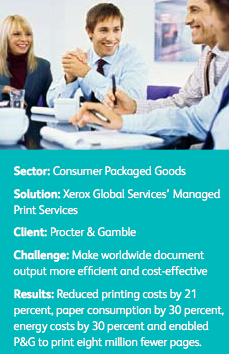Challenge
With 135,000 employees in 80 countries, Procter & Gamble produces millions of documents annually. Not long ago, those documents were output from 45,000 individual copiers, printers, scanners, fax machines and other devices. And each device was shared by only four employees, on average. In fact, P&G’s 200 facilities worldwide were free to buy their own devices and supplies independently.
 “It was absolutely not efficient,” says Caroline Basyn, P&G’s director of global business services. So Basyn proposed transitioning all P&G printing to a single provider. “I wanted to manage the whole worldwide print fleet as if it were one printer,” she says.
“It was absolutely not efficient,” says Caroline Basyn, P&G’s director of global business services. So Basyn proposed transitioning all P&G printing to a single provider. “I wanted to manage the whole worldwide print fleet as if it were one printer,” she says.
Enter Xerox.
Solution
In 2008, we signed a Managed Print Services (MPS) contract with P&G. Immediately, we applied our Lean Six Sigma process. Our team assessed the company’s document-driven processes, and identified ways to help employees work more securely and efficiently.
We worked with P&G employees to gather accurate data on the time they were spending on document processes. We also conducted individual and group interviews (complete with actual stopwatch timings) with employees as they performed various tasks.
 By documenting, measuring and tracking end-user processes, we identified a new process to improve productivity, reduce waste and generate savings.
By documenting, measuring and tracking end-user processes, we identified a new process to improve productivity, reduce waste and generate savings.
The combination of Lean Six Sigma and MPS has proven a winning duo. Through more efficient document management, P&G has slimmed its print and copy fleet from 45,000 devices to 10,000. And there are now, on average, 14.3 employees using each device.
Result
The typical end-user saves more than 200 minutes per year (a company-wide time savings of 138 business days annually). The benefits for device administrators are even more impressive: an average of 650 minutes saved per year.
 Beyond employee productivity, P&G has realized substantial cost savings and sustainability benefits. Xerox now manages the company’s global print operations, from print shops to offices. With 139 sites transitioned thus far, P&G has reduced printing costs by 21 percent, paper consumption by 30 percent, energy costs by 30 percent and enabled P&G to print eight million fewer pages.
Beyond employee productivity, P&G has realized substantial cost savings and sustainability benefits. Xerox now manages the company’s global print operations, from print shops to offices. With 139 sites transitioned thus far, P&G has reduced printing costs by 21 percent, paper consumption by 30 percent, energy costs by 30 percent and enabled P&G to print eight million fewer pages.
“The equipment is much more reliable, and our employees can use it anytime, anyplace,” says Basyn. “Managed Print Services gives them minutes back in their day, so they can focus on taking care of the business rather than printing.”
 Click here to download the full PDF of this Xerox case study
Click here to download the full PDF of this Xerox case study



